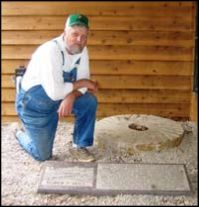
In 1880 Iowa had 713 flour and grist mills and 328 sawmills, most of these mills powered by water.
Milford Mills This ad appeared in the Nevada paper in the spring of 1877 when Soper's Mill was, for a matter of a few years, referred to as Milford Mills. It is interesting to compare this ad with an ad that appeared at the same time concerning a farm for sale "within 40 rods of Soper's Grist Mill". The Sopers would have owned the Mill at this time so it would appear that Hipsher and Eagleberger would be leasing it from the Sopers. It would seem the two names might be interchangeable in usage. Also, about this time, both in Story City (1880) and Nevada, there were constructed steam operated grist mills. It is reported that Hannan's Mill, about three miles north of Ames on the Skunk River, installed a steam operated grist facility about this time. This put a level of economic pressure on the Soper's Mill that when the droughts of the 1890's (and particularly the one of `94 and `95) caused the rivers (not only the South Skunk but all the rivers of central Iowa**) to literally quit flowing, Soper's Mill was unable to get started again. Water powered grist mills gradually became an obsolete (though practical) method of milling grain. Furthermore, following the installation of miles and miles of tile and open-drainage ditches,

A Little Early History of “The Mill”. Evidence exists in the biography of one of Thomas R. Hughes' children that Hughes did, in fact, grind some flour at the Mill during his ownership of the Mill from 1856-1866. Reference is made to the many Indians who still roamed the area and how T.R. Hughes befriended the Indians and “gave them many bags” of flour ground at his Mill. Also, in Lydia Agnes Dodds' obituary, when talking of her Father, TR Hughes, it says he “erected the first sawmill on the banks of the river and later made a grist mill”. Conflicting reports state that the Mill operated as a sawmill for approximately fifteen years, another report says that Soper, immediately upon his purchase of the mill in 1866 put in grist stones. Perhaps Hughes, sometime during his ownership, did some modification that permitted both sawmill operation and grain grinding and Soper continued this until about 1869 at which time he exclusively operated the Mill as a grist mill. It is easy to speculate that by the time of the Civil War, and particularly toward the end of the conflict, the supply of available trees had been diminished to the point that the lumber being cut could not compete with other sources. Many ties for the railroad had been made and when the railroad went on west from Nevada after 1864, the ties could be obtained from elsewhere. There had been stories of farmers of the area taking grain to be ground 30 to 50 miles so the transition to exclusive grist mill operation can be understood.
